Photo


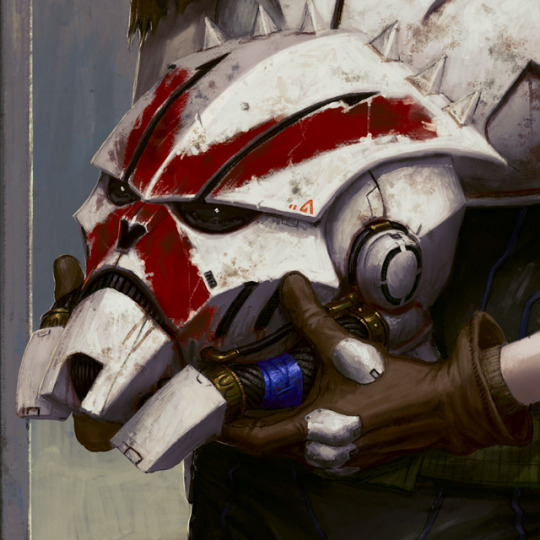

First actually polished work of 2019. My character, Gryr. I wanted to give her a face and finally some basic backstory. The artwork took some 10+ hours, I think. For comparison, I’ve included an original storyboard image from 2013 below.
Gryr was born on the Great Spire; her parents’ exact identities are not known to her, but she is borne from Magistrate blood. Due to her surpassing genetic quality, she was sent to the Ordinator Corps as an infant. There, she was trained from childhood to defend the City and quell civil insubordination using brutally effective techniques.
Relatively early into her career, Gryr grew disillusioned with the state of affairs within the City, and decided she needed to leave. For an Ordinator, this was unthinkable, and would result in crucifixion if caught. Nonetheless, she quietly spent years plotting her escape from the oppressive clutches of the City’s administration.
Eventually her overseer, Judicator Valkar became suspicious of Gryr’s behaviour, and tensions grew between the two for months leading up to her escape. The attempt at which failed, and Gryr was condemned to face the Grinding Spectacle. A small amount of last minute contingency planning and efforts from the underworld friends she’d made leading up to the escape helped her to avoid death and narrowly slip between Valkar’s talons.
From this point, having spent days evading search parties, Gryr eventually came into contact with a small Outcast establishment. Tensions were high as Gryr’s uniform and origin evoked fear in outcasts who knew what she was, but in time the situation began to relax. She was allowed to join the establishment and serve, what she believed, to be a humbler and more humanly purpose.
23 notes
·
View notes
Text
I also made a Twitter
I will be uploading some art and other nonsense there, too, following the purge on this site.
https://twitter.com/Houndhammer
2 notes
·
View notes
Photo
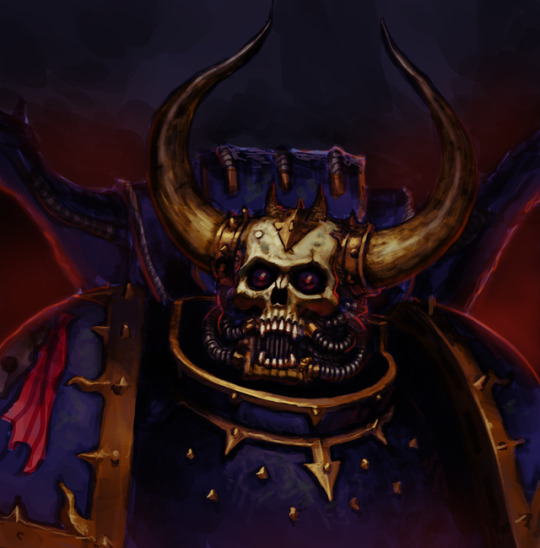
Warhammer Night Lords speedpaint (1h44m)
Done for a digital painting demonstration which you can view here: https://youtu.be/6cncHSp8SOA
68 notes
·
View notes
Photo

Generation 1 combat armour:
During the civil war, soldiers were outfitted in a type of armour now referred to as “generation 1,″ although that is a loose term to describe everything that came before the standardised and more visually-unified generation 2 system.
Early gen. 1 armour came from Earth, and was made from ferrous metal alloys. In the years following the abandonment of mankind’s homeworld, more and more of it was sourced from the rich Cobalt reserves of their new home.
The armour’s composition is primarily of hard metal plating coated in a dispersive finish, backed by sleeves of ballistic fluid, and finally padded for comfort. All in all, the suits were very heavy, and rather taxing to wear. Eventually, they were integrated with machine frames and further expanded with more armour plates. This formed the most iconic version of what most people consider “generation 1 armour.” The suits were moderately effective at keeping soldiers alive in the maelstrom of extreme intensity that was civil war combat, but due to the expenses of producing a full, mechanised suit, most soldiers were issued a stripped-down version that only protected the head and upper body. Full suits featuring machine-frames were mostly reserved for commandos and officers only.
Generation 1 armour did not have a single design, unlike the gen 2. Many manufacturers produced their own versions based around the centralised concept. The war was a fertile testing ground for innovation by manufacturers and soldiers alike, and a great spectrum of different designs and modifications, of varying levels of quality, could be seen.
Generation 1 would be gradually phased out of military circulation after the implementation of the gen. 2 system. It can still be found in bits and pieces, but most intact antique suits reside in private collections. Special forces commandos still wear an updated version of the generation 1 machine armour.
Body armour not belonging to mainstream military forces is exempt from the generational classification, and exists in a variety of forms on everyone from bodyguards to criminals.
3 notes
·
View notes
Photo

Concept for a typical current-generation soldier within my setting. I used a more time-effective technique than the last concept, and I like the outcome.
===
Soldiers such as this form the bulk of civilised human military forces. Each province governs its own military division, and while the Magistrates co-operate on how those militaries are used, and the militaries operate on a standardised structure and chain of command, each has small variances in culture and behaviour.
Soldiers are fed a highly nutritious but bland staple of vat-bred proteins and fats, in a starchy carbohydrate-laden paste. Various candies and drinks are provided in addition to add flavour and novelty. The nutritious paste contains pharmaceuticals designed to alter the emotional state of the soldiers. This makes them generally content with their state of being, but emotionally and sexually suppressed for as long as the drugs remain in their bodies. This gives soldiers the characteristic “robotic” behaviour for which they are known and at times made fun of.
In addition to their diet, soldiers are brutally conditioned and trained. Exercises are often physically and mentally exhausting, bordering on torturous. The end result is that trained soldiers are highly competent and disciplined, and able to remain cool in all but the most extreme situations.
Because military service is voluntary, soldiers are offered lucrative incentives to subject themselves to this career, and are offered the right to live and work in the higher echelons of the Great City after a term of service. For many soldiers whose background comes from the crime-ridden lower levels, this is an opportunity to escape the gangs and bloodshed of their previous life.
===
Most soldiers are outfitted in generation 2 combat armour. This armour is made from a ballistic thermoplastic polymer, and is significantly lighter-weight than the generation 1 metallic armour, though not as robust. The communications harness and optics inside the helmet have also been improved greatly over the generation 1. Generation 2 was developed as a way to move away from the heavy and brutal generation 1 system, which required a costly exoskeletal frame to be used at full capacity. Without which, soldiers often complained and discarded parts of their armour for mobility.
The generation 2 combat armour is mostly user-serviceable. Individual pieces of multi-part components can usually be swapped out by the user. In particular, the helmet is very user-friendly, and air filters can be snapped on and off the helmet with a fairly simple mechanism. The whole faceplate and optics system can also be disconnected in safe atmospheres to eat and breathe more freely.
The armour connects to a flexible harness that is worn over the one-piece combat uniform. It comprises of a helmet, a gorget, a four-piece connected cuirass which articulates at the abdomen and lower back, two bazubands, one of which houses a small, multipurpose computer, articulated greaves, pauldrons, and armoured gloves. A flexible ballistic pad further protects the abdomen and groin, and this is fixed to the belt and around the abdomen. The soldiers also wear an adjustable webbing over the armour to carry ammunition and equipment.
Additionally, speciality articles are available for the suit.These include cuisses to protect the thighs, and re-breather hoses that replace the “lower jaw” filter of the helmet. Faceplates can be swapped out for alternatives that feature different optics. The square studs adorning the helmet can be easily disconnected, and in their place accessories can be mounted.
12 notes
·
View notes
Photo

The Grand Magistrates are the oligarchic masters of the civilised world. Twenty-six in number, they were bred with the specific purpose of maintaining order over the new world after its colonisation.
The Grand Magistrates were genetically created to epitomise human perfection. Each one a natural leader, tall and strong, with potent intellects and dominating charisma. Those who have seen the faces of the Magistrates regard them as being of transcendent and ethereal beauty.
Despite their extensive lifespans, which reach hundreds of years, Magistrates eventually retire and die. Their successors are clones of themselves, which are fed information and memories from bygone lives. To the public, this gives the illusion of immortality, though in reality they must succumb to death as any normal human would.
Before the great civil war that would reduce the new world to tatters, each one ruled a roughly-equal province of the world, with the capital of each province being walled inside the colossally-expansive great City, where the Magistrates themselves live - at the top of a towering central spire. However, after the civil war that would see the world turned to little more than a violent, ashen waste, the provinces would themselves be reduced to the capitals only.
The Magistrates do not micro-manage their entire province. Over layers of governors, generals, and Judicators, they preside, and each Magistrate would have his or her will carried out with complete obedience by those elite servants.
After the civil war, the Magistrates’ policies would turn far more restrictive. In the interests of preserving the overall welfare of their subjects, they would enforce a policy of permit-only entry and exit to the Great City. This would cause a lot of rioting and city-spread violence which would eventually be quelled by curfew and the widespread, lethal actions of the Ordinator corps. While the relatively short period following the war was itself blood-soaked, the population eventually learned that there was little for them outside the walls, and for the most part, resumed their lives.
Those left alive outside the city after the war would form settlements of their own, or join legions of barbaric outlaws, cannibals, and raiders. Many resorted to a sordid subsistence in squalid camps around the city walls, living on bones upon bones of their fallen predecessors for generations, hoping by some miracle to be allowed the privilege of entry to the last known civilised human population centre. According to City politics, these people were no longer human, and could never be allowed to enter the city again, for fear of what they could bring to this bastion of humanity.
====
The Great Lion is the twelfth provincial magistrate. Like all magistrates, he is named after a creature from Earth, either real of mythical, and his opulent suit of machine-armour reflects its visage.
Among the more popular Magistrates, he is known for being a legendary strategist, and played a key part in defeating the rebellion during the civil war. Despite the arrogance of which all magistrates are accused by the general public, it is not below the Lion to extend compassion to his underlings, from time to time.
In his spare time, The Lion is known to enjoy battle-sports, and likes to spar with his generals in simulated wargames and physical matches of finesse. In his lavish home within the cloud-piercing spire, he keeps dozens of concubines, any children borne of which are evaluated and selected for the Ordinator-corps, due to their surpassing genetic potential.
The Lion is also the master of the Orion Penitentiary, the expansive prison-mining complex, which sees criminals forced into labour to provide minerals and other resources to the city. There are three such programmes spanning the planet, with the other two being Draco and Hydra - each overseen by other magistrates.
22 notes
·
View notes
Photo
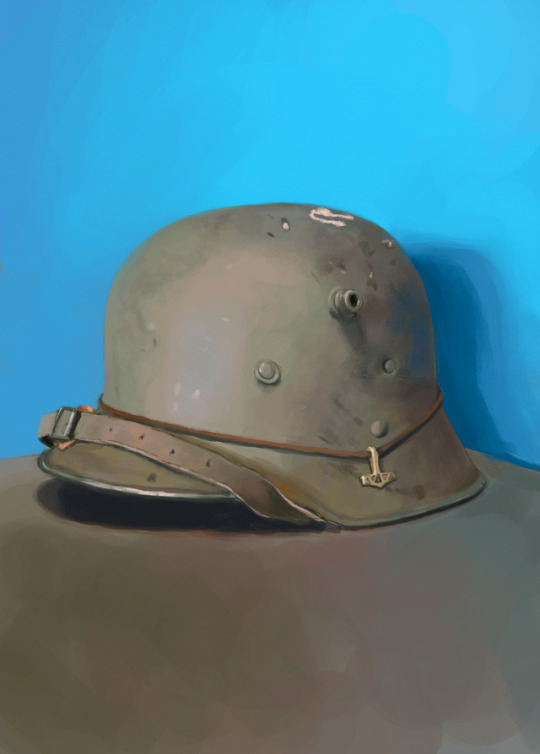
Quick-ish study of my Austro-Hungarian m17 stahlhelm. I didn’t manage to capture the overall grittiness of how the thing looks in person - the blemishes are very fine and cover the entire helmet. The white at the top is paper, or cardboard or something, that seems to be stuck down to the helmet. Been there since I got it. Weird, dunno.
8 notes
·
View notes
Photo

My first commission in a year or two.
The client requested a depiction of their fantasy D&D race called “Immerschlaf“ or “Eversleep” in English.
11 notes
·
View notes
Photo

Within the great armies of the Grand Magistrates, machine-soldiers are commonplace, and take many forms. Among the stranger examples are the ghoulish machines of the Death Cult.
The Death Cult is an officially recognised religion, and has possessed a sizeable following even prior to the final cataclysmic events of Earth’s history. Most prevalent among its numbers are servicemen of the regular army. While not all military personnel are affiliated with the cult, it is nonetheless respected and accommodated by the governing structures.
Following early attempts by the cult to enshrine the bones of deceased members-of-note into walking reliquaries, the idealistic notion that a warrior could continue to wage war even through death took hold, and so the Death Cult’s own machine-soldier was born.
The machines are comprised of a human skeleton, his bones strengthened with metal supports, printed with the necessary electronic circuits, and finally coated in a protective resin. In his skull is implanted a primary computer, with a basic combat drone AI. A backup computer sits in the chest, in case the head is destroyed. Generic actuators replace the original bone joints, adjusted to fit the dimensions of the specific skeleton. More actuators are fitted to the bone structure, and wired into place using the surface-printed circuitry. Hands and feet are replaced with durable prosthetic alternatives of varying sorts. Finally, the skeleton is permanently outfitted with a suit of metal armour, the design of which has varied throughout the years.
The machine-soldiers became a popular military unit for many reasons. They didn’t need to eat, sleep, or breathe, and they didn’t require payment. While the very first Death Cult machine-soldiers were hand crafted, the government funded the Resurrection programme, enabling several runs of automated manufacture for these units, processing thousands of deceased cultists and turning them into functional machines. Compared with more advanced military drones, these machine-soldiers were cheap to manufacture, and were lovingly serviced by cult personnel.
These machines, while slow on their feet, and lethargic in their movements, were competent gunmen, thanks to their targeting computer, and could aim more accurately than a flesh-and-blood man. Like all machine-soldiers, they made excellent snipers, and could lie in wait for months on end; unmoving as though made of stone. Likewise, their lack of basic needs made them appropriate as sentries and bodyguards, although prolific persons would more likely choose a more expensive bodyguard drone.
Death Cult machine-soldiers were deployed in great numbers during the Repto-Humanoid genocide, as their tireless pursuit of targets put them at an advantage over human alternatives. As a result, very few human lives were lost during the event.
With improved technology, the costs to produce fully inorganic machine-soldiers declined, and eventually it became less viable to fund the Death Cult’s Resurrection programme, and so the large-scale production of these specific units came to a close. They are still produced to this day, although they have returned to the old ways of dedicated individual production, each one a respectfully crafted tribute.
While the Death Cult have reclaimed most intact examples, they can still be rarely found standing wherever they were when their battery expired, covered in ash and dust. Their old ferrous armour and weapons rusted together, more like a statue than a machine.
15 notes
·
View notes
Photo

Concept art for my fairly unoriginal sci-fi setting, Necropolis.
The Repto-Humanoids, as they would come to be known, were the preeminent species on the rich planet that Humanity would settle upon, before destroying it utterly in hundreds of years through war.
Repto-Humanoids are a reptilian, bipedal species standing a head and shoulders above average human height. On their backs was a crest of coloured hair, like the mane of a horse, although far coarser. They were warm-blooded and appeared to be similar in intelligence to humans, however they lived in a state of comparative primitivism, technologically very similar to the middle ages of Earth, although with differences existing in societal structure.
With Humanity’s fleet of colony ships in orbit, the planet was surveyed for years while passengers were reawakened from Necrostasis following their centuries-long voyage. Numerous specimens were kidnapped by abductor-drones and taken to the colony vessels where they were closely studied, and ultimately killed.
With the realisation that the civilisation of the Repto-Humanoids was planet-wide, Humanity’s masters came to the decision that room was to be made for their arrival, and that sharing the resources of their new, smaller home planet with a competitor species was not viable after such exorbitant costs and effort had gone into their journey. Therefore, under the unified decision of the original 26 Grand Magistrates, a genocide campaign was enacted to clear the Repto-Humanoids from the new world.
As the planet’s welfare was considered paramount, few orbital bombardments were carried out by the colony fleet’s warships, except for the purpose of desolation of major cities and fortifications. The remainder of the genocide was conducted by machine-soldiers and relatively small armoured detachments.
While physically larger and stronger than most men, the Repto-Humanoids were easily overcome in combat due to their crippling technological disadvantage. Adaptations by the Repto-Humanoids in combat tactics during the later period of the genocide helped prolong Humanity’s effort to eradicate them, but the campaign was ultimately a success, and the legacy of the Repto-Humanoids would be almost completely erased.
While they were not driven to total extinction, the Repto-Humanoids would be reduced to a minority of the lowest order, permanently ensuring that there would be no chance for them to regain the grip they once held on the planet.
In the current year, there is no official policy to warrant the further extermination of Repto-Humanoids, and they are now considered no different to any other dangerous wild animal. They are thought to exist in small nomadic tribes, more primitive than ever before. To witness a Repto-Humanoid in modern times is to see a once-in-a-lifetime oddity.
13 notes
·
View notes
Photo

A comparatively quick painting of a gravely injured mech pilot facing his doom. I was inspired by some shitty manga (in which I rarely indulge), Front Mission: Dog Life & Dog Style, I think it was. Anyway, it didn’t hold me enough to finish it, but I liked some of the ideas.
I tried to keep the painting loose, and didn’t polish it down to the most miniscule details, as I normally feel compelled to do.
5 notes
·
View notes
Photo

And now for something completely different.
69 notes
·
View notes
Photo


NECROPOLIS: PART 1 - SAMAEL
I’m storyboarding a short concept for a comic that takes place during the Great Planetary War of my sci-fi setting. This is the third section.
Delay while I figure out what Huginn and Muninn look like lol
3 notes
·
View notes
Photo


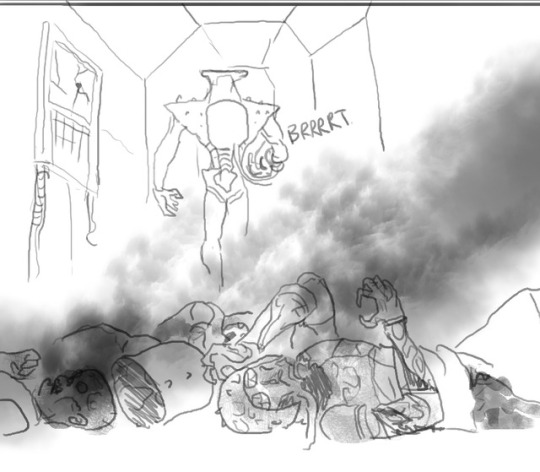
NECROPOLIS: PART 1 - SAMAEL
I’m storyboarding a short concept for a comic that takes place during the Great Planetary War of my sci-fi setting. This is the second section.
12 notes
·
View notes
Photo
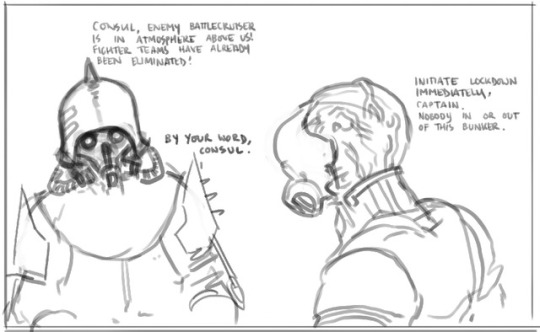
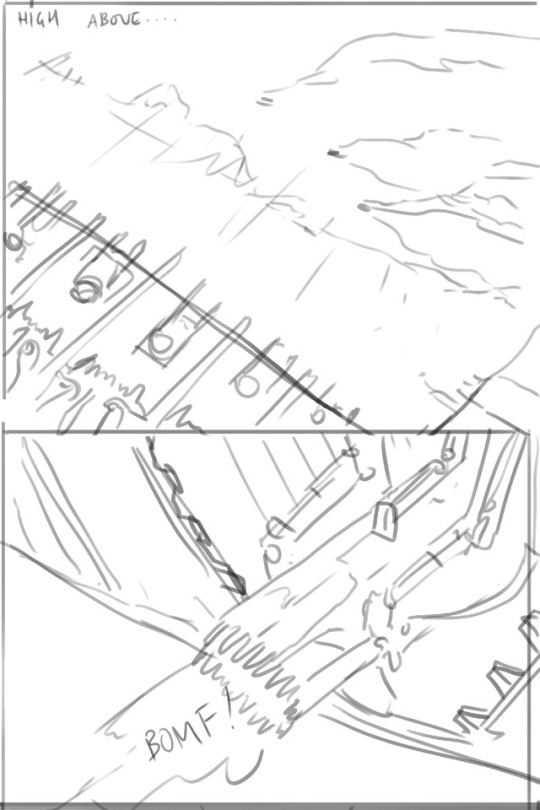




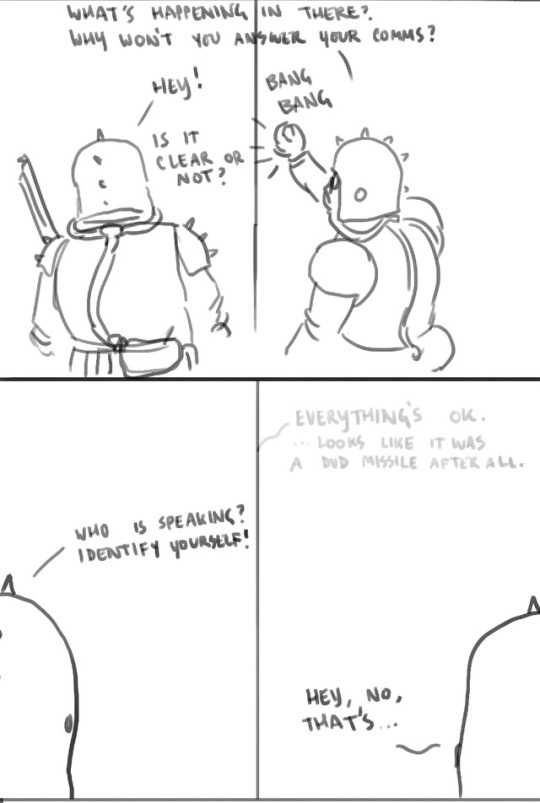


NECROPOLIS: PART 1 - SAMAEL
I’m storyboarding a short concept for a comic that takes place during the Great Planetary War of my sci-fi setting. This is the first section. More incoming.
14 notes
·
View notes
Photo

My entry for the Militant-Zone art contest.
29 notes
·
View notes